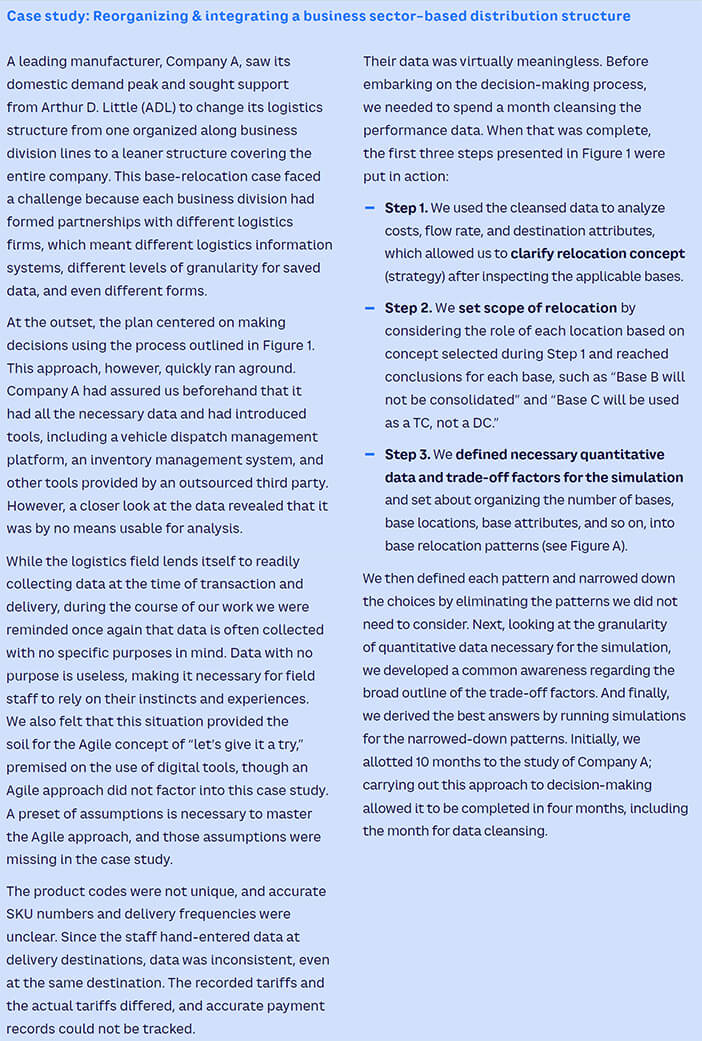
Due to huge changes in market dynamics and customer behaviors since the COVID-19 pandemic, globally, the logistics field has been forced to make rapid and irreversible decisions in recent years. Base relocation is an example that requires effective decision-making. The goals are to optimize costs and look beyond logistics to maintain consistent supply chains. Using Agile principles to prioritize speed is not viable, and relying on only digital tools is risky. In this Viewpoint, we present an approach to addressing the complicated matter of base relocations.
“GIVE IT A TRY” IS A DANGEROUS APPROACH
In 2021, the logistics field reached a major milestone: global trade exceeded US $28.5 trillion, a record high, thanks to the rising price of natural resources and a rebound of economic activity that followed the end of COVID-19 restrictions. In this environment, supply chain costs have escalated, and executives are increasingly under pressure to optimize these costs to get the most value for their investment.
The growth of e-commerce, including cross-border e-commerce, has made it necessary to consider digitalization and the establishment of optimal logistics for both small and large businesses around the world, which is long overdue. Issues such as economic security, human-rights protections, and other geopolitical risks are necessary concerns that business managers in the logistics field cannot overlook.
Agile began as a software development method intended to effectively structure projects into steps, and its strong affinity with digital contributed to its long history within the industry. As the demand for digital transformation grows and pressure to convert digital to corporate value rises, Agile approaches and methodologies are gaining attention in management decision-making processes and governance. Therefore, taking an Agile-inspired “let’s give it a try” approach is common when making decisions about digital transformation. Even important strategic decisions, such as relocating logistics bases, become examples of “digital reliance.” Later in this Viewpoint, we highlight a successful relocation strategy to show the importance of starting with concept-making while considering digital tools in-depth and waiting to use them, instead of adopting them immediately.
While the interpretation and understanding of Agile methodologies may differ from one person to another, overall, Agile can be viewed as a concept aimed at improving speed in business management. It is the notion that actions result in experience and information, which can be applied during subsequent steps.
The basic qualities of the logistics field create a natural affinity with Agile methodologies. Many aspects of logistics can be improved through the use of digital tools (e.g., defining optimal delivery routes or providing detailed ton-kilometer calculations). As the pace of digitalization and use of digital tools accelerate, the relevance of Agile concepts in decision-making grows.
MAKING DECISIONS ABOUT DECISIONS
People who run businesses are pressed to make decisions on a daily basis. The matters subjected to these decisions vary widely, from those that are clearly important in terms of urgency and size of impact to those whose importance is difficult to judge at first look. When determining the amount of time and resources to devote to the decision-making process, it must be acknowledged that a judgment has already been made by the business whether the decision under consideration is reversible or irreversible.
Accordingly, when converting the precious resource of business leaders’ time into corporate value, it should be clear who or what the decision is going to affect, followed by careful thought into the kind of decision that needs to be made. Once the matters subject to decision-making have been selected, they must be filtered through an analysis to determine the number of resources available for the process.
The thinking involved in this art of decision-making and governance is critical, along with the content to be studied, in order to ensure that business managers make quality decisions. This is not a clear-cut process. Most people, however, are familiar with their company’s internal dynamics, such as the need to get approval and share information with a certain department or person before proceeding with managerial decisions.
When management moves along with initiatives involving digitalization, the decision-making process does not necessarily have to be Agile-based. In fact, when the decision under consideration is irreversible, the “let’s give it a try” approach is highly risky due to the required investment, the lengthy time frame, and the difficulty of undoing a change.
Even at Amazon, not all decision-making is based on an Agile approach alone. The management approach at Amazon revolves around asking, “Is this decision a one-way door or a two-way door?”:
-
A two-way door decision is made with an emphasis on speed, while acknowledging a certain amount of risk.
-
A one-way door decision is made with more care and thoughtfulness.
The emergence and expansion of digital in recent years have made it easy to keep track of the link between sales and production data or the number of processes and the hours required for each process. In recent years, an environment has been developing to facilitate digitalizing the analog experiential knowledge and intuition that skilled managers and workers built during the course of their careers.
IRREVERSIBLE DECISIONS
When a company’s workplaces are scattered geographically, the duties of the players at each location tend to be finely apportioned. Yet, logistics is a field characterized by basic qualities such as single cycles, real time, and ease of quantification/visualization. Logistics also relies on solid decision-making. Many of the decisions in the logistics field are irreversible, but until recently, the need to make such irreversible decisions has been extremely limited because the cost of reform is high. Now, the industry is at a turning point, which means small, ad hoc changes must be exchanged for larger dynamic changes. Accordingly, the process of regularly making easily reversible decisions has relied on the plan-do-check-act (PDCA) cycle, which has become deeply rooted in company culture.
Recently, however, a series of irreversible decisions have been made in the logistics field, the kind that traditionally would only be expected to occur once every several years or even decades. These include, for example, operations involving human life and mission-critical operations that, if stopped just once, would impact the entire supply chain, or the customers and society who depend on it. Irreversibility has nothing to do with Agile, however, and is defined as an irreversible decision due to the size of the investment and the difficulty of undoing it. Our understanding of the context for these irreversible decisions is the shifting environment of the logistics industry, which has brought it into the middle of a game-changing transformation from a human labor-intensive industry to an equipment industry, relying on machine-based systems to produce goods or provide services.
Using a digital-only option brings the risk that incomplete data could lead to lengthy and resource-intensive activity to gather and cleanse the data, but ultimately errors in understanding the data can lead to the wrong decisions, which are often not realized until they are enacted. Using data intelligently through careful selection and simulation is the key to developing the optimum solution within reasonable budgets and time frames.
DECISION-MAKING & BASE RELOCATION
Among the irreversible decisions in the logistics field, the issue of base relocation is particularly troublesome for logistics practitioners. Setting the targets, such as costs and service levels, is the easy part. However, the factors and choices to be considered during the decision-making process are numerous, and the required expertise is fragmented across various areas, including real estate, in-warehouse management, shipping, and delivery.
Moreover, the base-relocation issue lies at the intersection of the strategic perspective and the field knowledge perspective. It is especially important to convert the qualitative views and situations acquired from the field to the quantitative figures demanded by management.
Ordinarily, logistics practitioners would not come up against the base-relocation issue more than once or twice in their career. Encountering this challenge so infrequently puts them at a disadvantage, as their experience and knowledge concerning such a large undertaking would be limited. Preparing enough quantitative data to help management make a decision, while devising explanatory logic that includes qualitative information, may feel next to impossible for logistics practitioners, who are still busy with onsite management.
It is not difficult to imagine that decision-making conditions like the above make many enterprises want to take an Agile approach informed by digital tools. In reality, there are increasing opportunities in the logistics field to observe approaches introducing simulation and decision-support tools, followed by initiatives that build on the experience and information gained from using those tools.
Unfortunately, achieving success in such an approach is difficult. Indeed, we are unaware of any cases where an irreversible decision, like base relocation, was addressed successfully by an approach relying on digital tools. We believe the approach is faulty because people start with the idea of “let’s give it try” without considering the essence of the project. Relying on tools without a plan or goal almost always results in failure.
Making use of digital through a non-digital approach is a conscious decision. Digital can demonstrate its worth only when decision-making occurs in a proper flow. Figure 1 illustrates the flow of decision-making in base relocation. For the purpose of this Viewpoint, we focus on the three “non-digital” decision-making steps involved in base relocation (those that occur before the use of digital simulation tools), and the case study below illustrates what this process looks like in action:
-
Clarify relocation concept (strategy). The matters under consideration and their scope, the evaluation axes of the simulation, and other factors will differ, depending on the objectives of the base relocation, whether it is to reduce costs, improve service levels, support business continuity plans (BCP), or other purposes. Especially in the logistics field, the resolution of information can be made as detailed as necessary. Standard practice is to obtain an overall picture first, then prioritize and do a deeper dive.
-
Set scope of relocation. This process identifies the geographic area of the relocation and the extent of the supply chain inside and outside the company, including business partners, to be considered in the relocation. During this step, the differences in base functions, such as distribution center (DC), transfer center (TC), or front distribution center, are examined, in addition to the differences in forms of asset holding, whether they are leased or owned.
-
Define necessary quantitative data and trade-off factors for the simulation. The quantitative and qualitative data needed for analysis are compiled. Next, the relationships are defined among data and trade-offs, such as convenience versus location cost. Studies from a BCP standpoint are carried out as well.
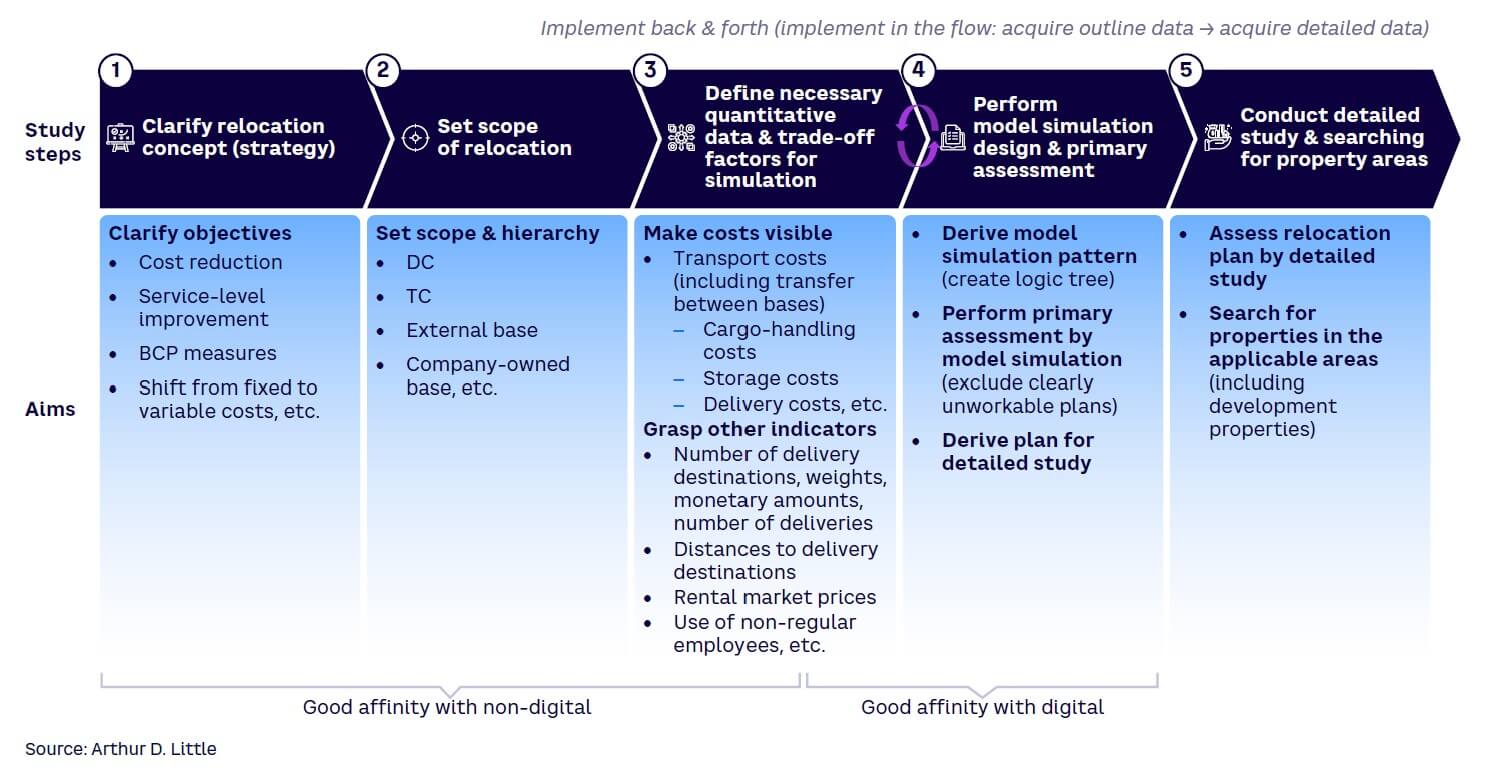
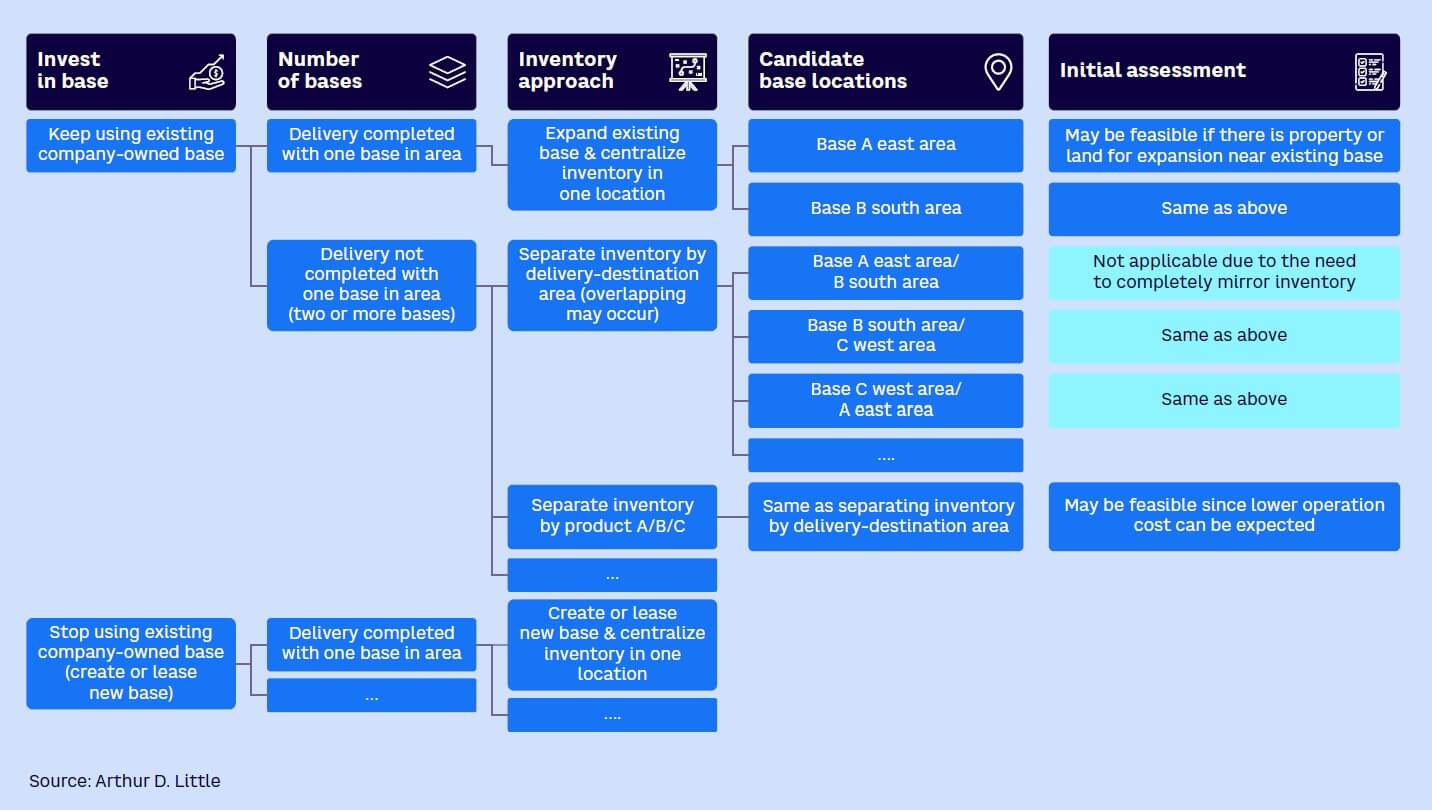
USING TOTAL DISTRIBUTION COST MODEL
In the Company A case, we adopted the total distribution cost model as a framework for studying the base-relocation problem. Figure 2 sets costs on the Y axis and the number of bases on the X axis, graphing the trajectory of transportation and delivery costs, base operation costs, and total distribution costs.
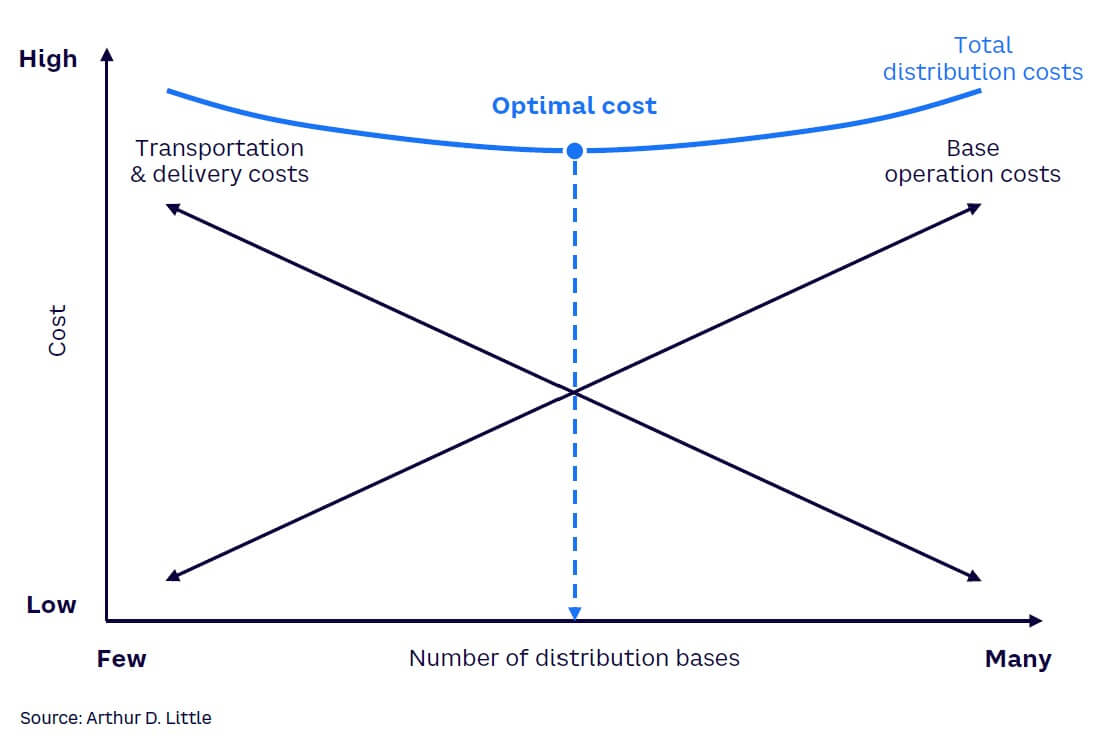
Transportation and delivery costs decline as bases increase, thanks to shorter transport distances. However, base operation costs rise when the number of bases increases. The total distribution cost, which is the sum of transportation costs, delivery costs, and base operation costs, is depicted by the “smile curve” in Figure 2. While this method is simple, it is also a readily understood way to grasp the broad outline of the base-relocation problem.
Because this model provides only a rough analysis, it is viewed as unsuitable for actual practice. To make it applicable to practical implementation, we elevated the precision of the analysis by breaking down the transportation and delivery costs, and the base operation costs.
Base operation costs were further classified into the following four broad areas:
-
Storage costs (land and building rents, berths, and other non-warehouse area costs)
-
Transportation costs (drayage costs, inter-base transfer costs)
-
Cargo-handling costs
-
Administration and personnel costs
Drayage costs and inter-base transfer costs are normally included in transportation and delivery costs and are treated separately from base operation costs. However, inter-base transfer costs and drayage costs rise as the number of bases increase; thus, this expense was included in base operation costs, while transportation and delivery costs mainly included only delivery costs incurred inside the geographical area (see Figure 3).
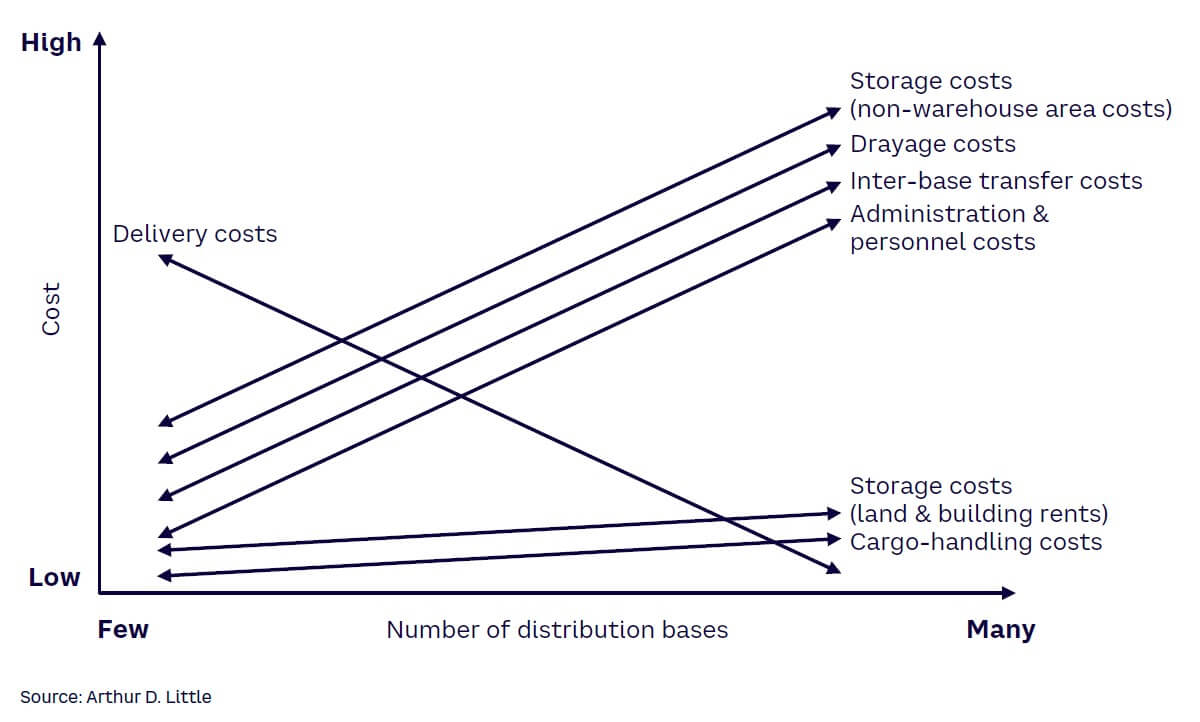
Depending on the area, these delivery costs do not necessarily decline even when the number of bases increases, a factor that requires attention. For example, when a city has a radius of around 100 km, like greater Tokyo, Japan, changing the number of bases or locations will not result in a decline in delivery costs, and the additional cost from additional bases cannot be absorbed. In cases where multiple bases are deployed within a specific-size locality, a general total distribution cost model is valid when it reveals a decline in delivery costs when bases increase and transport distance decreases.
Generally, if delivery destinations are scattered across a wide area, the distance of area delivery becomes longer, and the cost becomes higher; increasing the number of bases shortens the distance of area delivery and lowers the cost. However, when delivery destinations are concentrated within in a small area (within a radius up to 100 km), the area delivery distance is compact; increasing the number of locations will increase the operation cost for that area.
In other words, it is more efficient to minimize the number of locations when the locations are close to each other. Figure 4 illustrates the correct approach: arrange bases within a limited radius and concentrate them within that space to the extent possible.
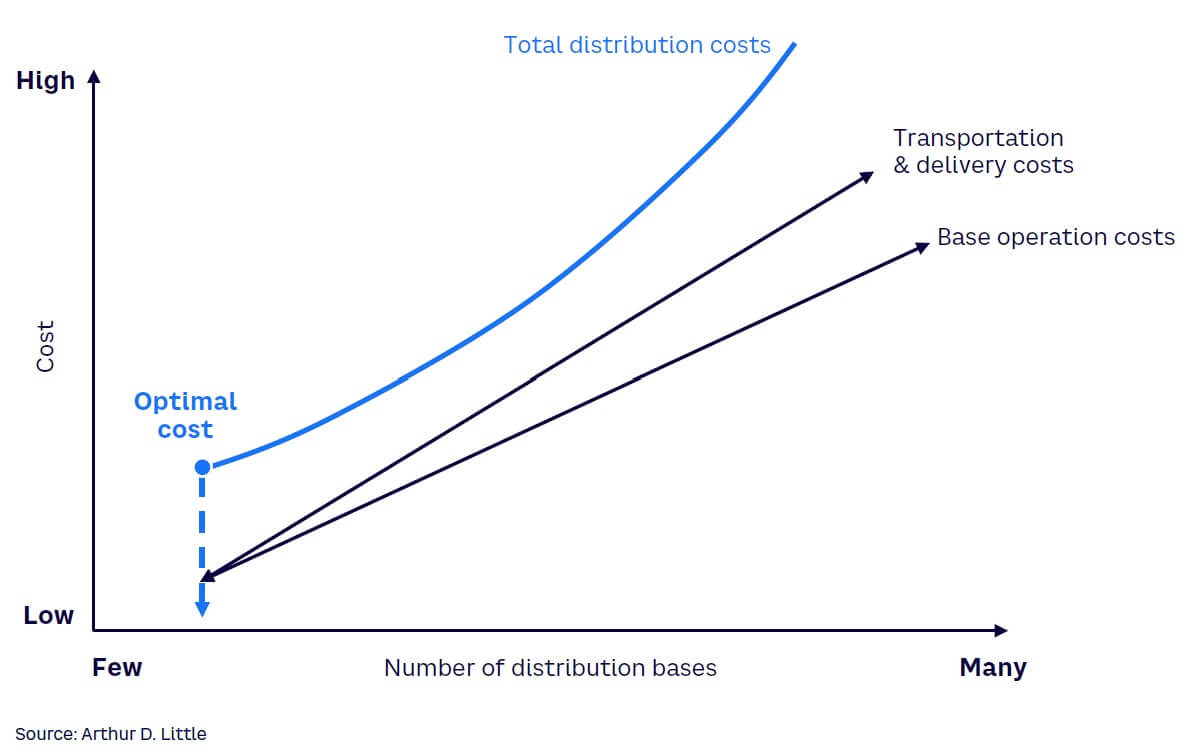
This conclusion aligns with the intuitive understanding of practitioners who are involved in logistics on a daily basis. Yet this conclusion can only be verified by correctly breaking down the total distribution costs and raising the resolution of analysis. Then it becomes possible to translate the instincts rooted in field knowledge into the language and logic that drive management.
Trying to run a simulation based on the total distribution cost model using analog processing would be a daunting, time-consuming effort. Digital technology makes it possible to quickly verify a variety of patterns multiple times — patterns that are produced by combining the input information for each factor and parameter in the simulation scenario.
The studied factors may change. For example, factors outside simulation costs include a change to the logistics strategy concept on which the simulation is premised, such as deploying east/west mirror bases for BCP support, considering modal shift, or configuring a hub-and-spokes structure. Trade-off factors are also subject to change. For example, the cost of land along Japan’s Ken-O Expressway is relatively low but so is the population. This lack of potential local personnel incurs hiring expenses because of increased labor and recruitment costs.
The optimal quality, cost, and delivery (QCD) is identified by repeating the simulations while changing the parameters, such as from/to flow rate, base attributes, delivery conditions, types and numbers of delivery vehicles, and delivery turnovers. In practice, this is impossible to execute with analog processing. However, QCD cannot be calculated by digital means alone. When using a non-digital approach as a premise, incorporating digital at the appropriate time is of utmost importance.
Conclusion
MAKING THE NON-DIGITAL AN INTANGIBLE ASSET
The logistics field is undergoing a major transformation due to digitalization and reexamined work styles, but it is dangerous to jump into digital tools because they appear easy to use. A non-digital approach and careful thinking can maximize the potential of digital. Keep the following at the forefront of decision-making:
-
Untested major changes require large investments in time and money; irreversible decisions should be properly considered from the start.
-
When considering site relocation, the decision-making process should not rely on a digital or Agile approach, though digital tools are necessary at the end of the process.
-
Consider the optimal location for each company while utilizing a total-cost model for logistics is key.
-
Digital tools alone cannot inform site-relocation decisions; a comprehensive decision considers BCP and securing a labor force.
In corporate management today, we stress anew the critical importance of equipping a company with intangible assets to effectively convert commoditized strategies to economic value.




